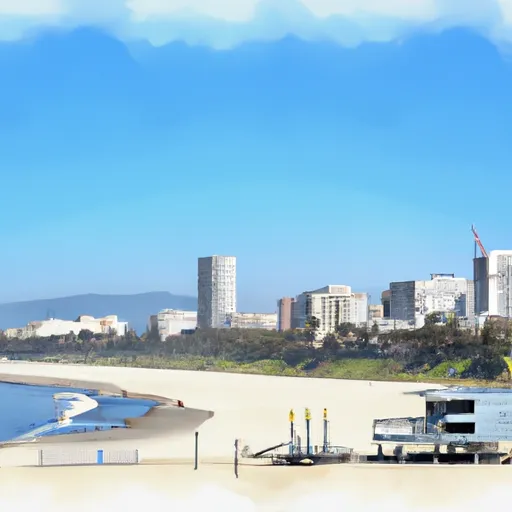-
 Snoflo Premium
Snoflo Premium
Get unlimited access to all our content
With no Ad interruptions! - Start Your Free Trial Login with existing account
Santa-Monica
Eden Index
Climate
9.2
•
Recreation
3.9
•
Community
5.9
•
Safeguard
6.5/10

Santa Monica is a coastal city located in the state of California, known for its idyllic climate, diverse outdoor recreation opportunities, and stunning natural beauty. The city enjoys a Mediterranean climate, characterized by mild, wet winters and warm, dry summers. With an average annual temperature of around 65°F (18°C), Santa Monica offers pleasant weather year-round, making it a popular destination for outdoor enthusiasts.
Situated along the Pacific Ocean, Santa Monica benefits from the hydrology constituents of the nearby Santa Monica Bay. The bay provides a picturesque setting for activities like swimming, surfing, paddleboarding, and beach volleyball. The city is also home to the Santa Monica Mountains, which offer opportunities for hiking, mountain biking, and horseback riding in scenic wilderness areas.
In addition to its coastal and mountain attractions, Santa Monica boasts numerous parks, including the iconic Palisades Park. This beautiful oceanfront park allows visitors to enjoy stunning views, relax in lush green spaces, and partake in activities like yoga and picnicking. Overall, Santa Monica's favorable climate, hydrology constituents, and diverse outdoor recreation opportunities make it a prime destination for those seeking an active and enjoyable outdoor lifestyle.
What is the Eden Index?
The Snoflo Eden Index serves as a comprehensive rating system for regions, evaluating their desirability through a holistic assessment of climate health, outdoor recreation opportunities, and natural disaster risk, acknowledging the profound impact of these factors on livability and well-being.
Climate Health Indicator (CHI): 9.2
Santa-Monica receives approximately
382mm of rain per year,
with humidity levels near 58%
and air temperatures averaging around
17°C.
Santa-Monica has a plant hardyness factor of
10, meaning
plants and agriculture in this region tend to thrive here all year round.
By considering the ideal temperature range, reliable water supplies, clean air, and stable seasonal rain or snowpacks, the Climate Health Indicator (CHI) underscores the significance of a healthy climate as the foundation for quality living.
A healthy climate is paramount for ensuring a high quality of life and livability in a region, fostering both physical well-being and environmental harmony. This can be characterized by ideal temperatures, reliable access to water supplies, clean air, and consistent seasonal rain or snowpacks.
Weather Forecast
Streamflow Conditions
Ventura-San Gabriel Coastal
Area Rivers
Ventura-San Gabriel Coastal
Snowpack Depths
Ventura-San Gabriel Coastal
Reservoir Storage Capacity
Ventura-San Gabriel Coastal
Groundwater Levels
Recreational Opportunity Index (ROI): 3.9
The Recreational Opportunity Index (ROI) recognizes the value of outdoor recreational options, such as parks, hiking trails, camping sites, and fishing spots, while acknowledging that climate plays a pivotal role in ensuring the comfort and consistency of these experiences.
Access to outdoor recreational opportunities, encompassing activities such as parks, hiking, camping, and fishing, is crucial for overall well-being, and the climate plays a pivotal role in enabling and enhancing these experiences, ensuring that individuals can engage in nature-based activities comfortably and consistently.
Camping Areas
| Campground | Campsites | Reservations | Toilets | Showers | Elevation |
|---|---|---|---|---|---|
| Dockweiler Beach RV | 117 | 45 ft |
Nearby Fishing
Catastrophe Safeguard Index (CSI):
The Catastrophe Safeguard Index (CSI) recognizes that natural disaster risk, encompassing floods, fires, hurricanes, and tornadoes, can drastically affect safety and the overall appeal of an area.
The level of natural disaster risk in a region significantly affects safety and the overall livability, with climate change amplifying these risks by potentially increasing the frequency and intensity of events like floods, fires, hurricanes, and tornadoes, thereby posing substantial challenges to community resilience and well-being.
Community Resilience Indicator (CRI): 5.9
The Community Resilience Indicator (CRI) recognizes that education, healthcare, and socioeconomics are crucial to the well-being of a region. The CRI acknowledges the profound impact of these elements on residents' overall quality of life. By evaluating educational resources, healthcare accessibility, and economic inclusivity, the index captures the essential aspects that contribute to a thriving community, fostering resident satisfaction, equity, and social cohesion.

